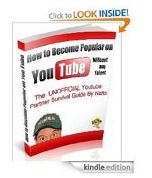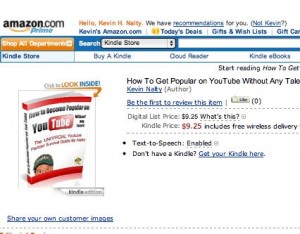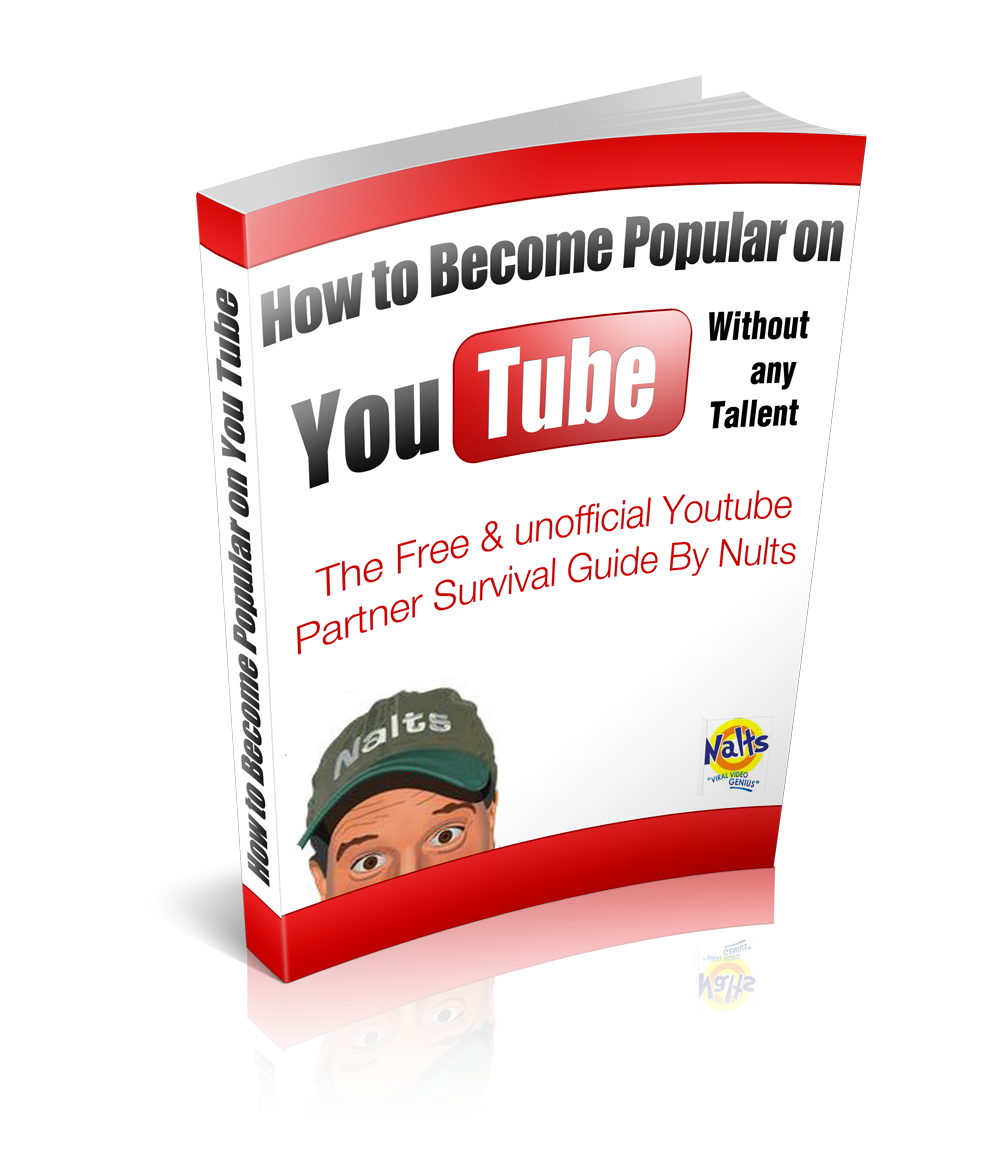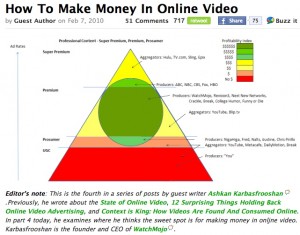Several trends are causing many independent “YouTube Creators” to sign with “new establishment” (web studios) such as Makers Studios (good luck finding its website), Next New Networks, The Station, Howcast and Machinima. Many early web studios were formed to create and promote custom shows for wide distribution. But the high investment ($1-$5K per edited minute) could not be sustained by the modest advertising dollars moving into the medium. In the past year, most have abandoned custom shows and are signing proven YouTube talent, many who have low costs, but large and steady audiences that are valuable to advertisers.
The trends driving these deals are:
- It’s a buyer’s market. YouTube advertising revenue is relatively depressed because it’s new and driven mostly by Google Adsense, which allows even small advertisers to target viewers. The revenue model is largely based on “cost per thousand impressions” (CPM), and the income to the creator is mostly hovering at a modest $1 plus range… obviously YouTube pockets a portion before the creator is paid. Since an advertiser is often willing to pay far more for a targeted view, there’s plenty room for an intermediary who can command higher CPMs. Despite Google’s large salesforce, the display team at Google is relatively small. As I’ve said before, most media buyers are opting to put dollars into other sites because YouTube is less flexible.
- Many solo acts have significant monthly views (mine alone are 5 million plus), but can’t justify selling their own inventory. However if a network can assemble a collection of creators that are attractive to certain industry advertisers, they can rationalize a salesforce and a premium.
- The marketplace for talent is growing increasingly competitive, making it more attractive to independent creators to share in such fixed costs as management, marketing and production. Many solo acts on YouTube lack even basic talent representation, and don’t know how to find sponsors or price their sponsorships (and some are not willing or capable).
- Budgets are flowing online dramatically, as video consumption increases. YouTube has missed a significant portion of online-video budgets because Google’s emphasis remains on paid search (while smaller properties are focused on pursuing larger digital budgets and even television budgets). This is changing, and could become more complex as the lines become less clear between YouTube (which has often proclaimed to be a platform not a network) and web studios (like its rumored acquisition, next New Networks).
- Cross promotion across creators can grow the size of an audience significantly, and collective groups (like The Station) can expose individual shows/stars to audiences that might not otherwise know they exist. Many creators have sought alliances because there’s strength in numbers. The brat-pack model is not to be underestimated, even though shared successful YouTube channels are rare.
While few web studios and creators will reveal detailed terms, here are a few models that I’ve seen first hand. I will avoid revealing specifics or suggesting which studios gravitate to various models. Even within the same web studios, the deals can vary dramatically based on the creator’s negotiating skills, their content quality, and their audience size. Most deals are more nuanced than the following, but here are some simplified examples:
- We own you. Small “up and coming” creators were often willing to effectively sell their show to a web studio and become compensated at a fixed price per episode. This is increasingly rare, as it is risky to both the studio (who can’t be sure the star/show will succeed) and the creator (who loses the otherwise unlimited upside potential of a solo YouTube artist).
- We own 50% to launch you. Some “web studios” sign new talent with a revenue split. A talented but unknown creator can gain accelerated growth via appearances in the network’s already popular shows, and in return provides a portion of his/her YouTube Adsense dollars to the studio. Both this model and the previous require the studio to “claim” the channel via YouTube, and then pay the talent in some form: usually a month after the studio is paid. YouTube is attempting to make this easier for the creator, studio and advertiser… but it’s still fairly complicated to execute. Since the creator can become blind to the actual revenue their channel receives, it requires some trust.
- We “mark you up.” Since the average ad CPMs remain modest, some studios are able to offer a creator/show a premium CPM (income per view) that is higher than that to which they’re accustomed… but sometimes capped. For instance, the studio may promise to pay the creator $2 per thousand views, and pocket any incremental revenue. This makes sense if the studio can sell the inventory at an ongoing premium, and is even more attractive to the creator if the studio can promote and grow the channel as well. However it means the creator may not benefit from what I’d expect to be higher CPMs in the years ahead.
- We split incremental proceeds. A more mature YouTube star may negotiate a deal where anything in excess of their regular YouTube “Adsense” revenue is split. The studio may, for instance, sell a series of sponsored shows to a brand or advertiser, providing a complement to typical display ads (prerolls, banners, InVideo ads). The studio also may offer additional “value ads” that are not easy to execute via YouTube directly (such as having a collection of creators promote the brand on their Facebook and Twitter profiles). The creator may occasionally get a fixed sponsorship income (a few grand) to provide messaging within the show, and the display ads are marked up during a specific timeline. We’ve seen programs like Howcast’s GE Healthymagination that involve a number of YouTube stars working together or sequentially. In some cases YouTube manages these directly, contacting top talent to participate.
- Pay per sponsorship. Some studios remain strictly in the pay-per-sponsored video space, providing advertisers with a flat fee for a series of videos that mention a product or service. A creator who fetches 200K to 1 million views per video can command o5-50K for a single sponsored video, and the studio takes a percent. Again, YouTube does many of these programs directly since the marketplace for these programs is still immature. Hitviews was one of the early companies for these, and Mekanism is doing some now. In my experience, it’s far more profitable to a creator to do them directly via YouTube… but there’s little a creator can do to increase the quantity of these. They’re bought not sold.
In this blog and my book, I’ve argued that advertisers and creators need intermediaries to facilitate sponsorship programs when they go beyond traditional ad buys (invideo, prerolls or adjacent display ads). When I consulted with Hitviews, I helped orchestrate some of these complex sponsorship programs, and they require skills that are rare in traditional and digital agencies. They’re difficult to sell, tricky to execute, and require cash reserves — since creators must sometimes be paid before revenue is received from advertisers. I’ve also done these directly with advertisers since I have a marketing background, but that’s not easy for most creators. Still, these sponsorships are lucrative for creators and extremely valuable for brands. They take the advertising message to where it has greater influence (within the show) and cannot as easily be ignored. They’re also perpetual annuities for brands. Some of my sponsored videos have garnered significant views long past the campaign’s period.
Audiences can be tolerant of these sponsored deals as long as the creative is strong, and a webstar or show does not do them too often. To see some of my own sample sponsored videos click here. You’ll see that most are not heavy on the promotion since that can severely impair views, ratings and comments. My income for these has varied radically, and often does not correlate with the total views of the videos. In a few cases, the advertiser has paid YouTube to “spotlight” the videos, but most of the views are organic.
I have seen some of my favorite YouTube creators fatigue audiences by accepting numerous sponsored deals (especially in a short time period). I’ve seen both extremes: the advertiser paying far more than it should (based on quality of the video or total views), or the creator selling out for a modest fee (and sometimes not paid at all).
Here are some tips first for advertisers/studios, then for creators. My emphasis is on sponsorships rather than “signing,” since the former is more common.
- Advertisers or studios should not, in my opinion, subsidize a show’s creation. That can get cost prohibitive to a brand, and can result in mostly paid views. Those are not nearly as valuable as “organic” views (where a show already has a recurring or loyal audience).
- I believe advertisers should provide at least 50% up front (like with any media buy) and withhold 50% based on performance metrics (total views). This ensures the studio has sufficient funds to attract and pay creators, and also reduces the risk to the advertiser. However it seems studios and YouTube often commence campaigns before getting paid, which results in ridiculous long gaps (3-6 months) between posting a video and getting paid for it.
- Studios (and advertisers) should be careful about the stars/shows they pick. Some have a reputation for delivering content that meets the needs of the audience and the brand, and others are known for turning in marginal content, missing deadlines, or even harming the reputation of the brand. It is difficult for someone not extremely familiar with YouTube and creators to vett them well. For instance, I was approached recently by Best Buy despite my disdain for the company.
- A good “match maker” will instantly know what creators/shows are right for different advertisers/sponsors, and that requires more than an understanding of a channel’s demographics. Since most popular YouTubers ignore e-mail, it’s not easy to catch their attention even when dollars are involved. If I had a dollar for every false-positive “sponsor,” I could buy YouTube from Google.
Creators:
- Creators should be very careful about signing “exclusive” deals, which limit revenue in other mediums or distribution channels beyond YouTube. I’ve been offered large monthly sums to move my content off YouTube and have never regretted declining. I’m also glad that I’ve never put a ceiling on my income, or provided any videos to a third-party with exclusively.
- Since the CPMs are likely to get higher in coming years, I’d be reticent to sign a deal that locks me into today’s CPMs. If an advertiser can command higher CPMs for a specific video or time period, that’s nice. However I wouldn’t want to lock myself into $1 per 1K views, and then watch the average CPM rise.
- It’s a good idea to have a time period attached to a deal, and opportunities for either party to exit. This is especially important since some of the web studios could be acquired by companies that may change the dynamics between the creator and the studio. It’s also important to have an agreement if an advertiser needs to remove a sponsored video (I’ve seen this happen more times than you’d imagine).
- I urge creators to seek clarity about studio-exclusivity deals. A smaller creator will delight at signing with a studio that provides lots of new sponsorships. However what happens if that studio isn’t selling deals? Or if the studio is asking the creator to promote brands they don’t like? Or if the studio requests more sponsored promotions than the creator feels is appropriate (Smosh)? Is the creator obliged to take whatever deal the studio secures, or can they decline? More importantly, what happens if the creator is approached directly by a brand? Is he/she still permitted to do a sponsored video, and if so, are they obliged to provide a percent to the studio? Part of the reason I haven’t worked with Hitviews in more than a year is because it resented me working with other companies (YouTube directly or Howcast), and yet wasn’t providing a steady flow of well-compensated sponsorships. I’m still a fan of founder Walter Sabo however.
- As online video begins to behave more like traditional television (where YouTubers are TV shows, and studios are networks like Fox or ABC) the dynamic could change dramatically. But it’s still a maturing industry, and deals very often favor one party far above another. So regardless of what is in writing, a relationship of trust is vital. There’s a certain “give and take” that is important for all parties involved (advertisers, intermediaries and show creators).
- In general, I would rather be known as a pushover than a jerk… and the race is a marathon not a sprint. I have been “screwed” a few times, and have left money on the table (and I’ve steered clear of those people since). But I try to be flexible and make concessions knowing it’s a small industry, and that a professional, low-maintenance creator is more likely to earn the long-term trust of a variety of players that can provide income and other opportunities.
- Finally, don’t be afraid to say “no.” I’ve seen several of my friends decline a modest or unfair offer, only to receive a much more generous one.
I’d welcome your comments if you have your own learnings… or your questions if I’ve been unclear. I’m sure it’s not an easy read, since it’s a complex space!
Lastly, if you’re a player in this space and regret not being mentioned, please identify yourself in comments or via e-mail. I am sure I have missed some web studios or intermediaries that are active in recruiting talent and wooing brands.









